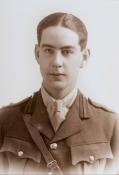
War Memorial
| Lieutenant Charles Ramsay BAYLY | |
|
128th (Howitzer) Battery, 29th Brigade, Royal Field Artillery Date of birth: 24th January 1894 Date of death: 29th March 1918 Killed in action aged 24 Buried at Anzin-St Aubin British Cemetery Plot IV Row B Grave 6 |

|
| Charles Ramsay Bayly was born on the 24th of January 1894 the younger son of James Arthur Bayly, a merchant, and Elizabeth Bayly of Peru and of 62 Old Broad Street London. He arrived in England from Peru, with his father and younger brother, on board the SS "Orita", landing at Liverpool in June 1904. He was educated at Hazelwood School from September 1904 to December 1907 where he was a member of the Football XI in 1906 and 1907. The school magazine wrote the following on his 1906 football season: - "(Goal keeper) - Improved enormously as the term advanced - his height is a valuable asset - at present his chief faults are slowness and indecision." Of his 1907 football season they wrote: - "(Inside right) - "Came on wonderfully as a forward, though his long legs never seemed completely under control; very slow at getting away, but at times a capable marksman." On leaving the school the magazine wrote of him: - "....goes to Marlborough; he has been of great service in the Football XI, both as a goalkeeper and also in the attacking line; if he does not outgrow his strength, his speed and stature should prove valuable at "Rugger"." He went on to Marlborough College where he was in Preshute House from January 1908 to July 1911. He was a member of the Officer Training Corps throughout his time at the College. He attended the annual camp in 1910, was ranked as a First Class shot and rose to the rank of Lance Corporal. On leaving school he continued his education at Compiegne. He returned to Peru where he worked for the firm of Duncan, Fox and Co. In 1912 he won the “Victor Ludorum” at the Empire Day Sports held in Lima winning the mile, the quarter mile and hurdles races. Following the outbreak of war he returned from South America with the first contingent of volunteers and applied for a commission "In any branch of the service" on the 29th of October 1914 in an application which was supported by Mr. Percy Taylor, Housemaster at Marlborough College. He underwent a medical examination at Queen Alexandra's Hospital, Millbank on the 1st of November 1914 where it was recorded that he was five feet ten inches tall and that he weighed 145lbs. He was commissioned as a 2nd Lieutenant in the Royal Field Artillery on the 3rd of November 1914. He was promoted to Lieutenant on the 1st of January 1916 and went to France in the same month and, on the 8th of October 1916, he was appointed as an Aide De Camp. On the 9th of February 1917 he was attached to the Headquarters of the Divisional Artillery as a Staff Lieutenant until the autumn of 1917 when he rejoined his battery. On the 21st of March 1918 the Germans launched a massive offensive in an attempt to break the deadlock on the Western Front. On the night of the 28th of March 29th Brigade withdrew to form a new line which was anchored on Fampoux Lock. Following their move back the enemy were "fairly quiet" but on the 29th of March the Brigade Observation Post received a direct hit which killed Major Harold Frederic Barker of 126th Battery, 2nd Lieutenant Leslie John Pickrell from 125th Battery and Charles Bayly. His father received the following telegram dated the 2nd of April 1918: - "Deeply regret Lieut. C.R. Bayly RFA killed in action 29th. Army Council express sympathy." A fellow officer wrote: - “There was no officer in the Divisional Artillery so universally loved.” He is commemorated on the war memorial at Marlborough College. |
|
| Went on to Marlborough College |
Back